I know it’s going to be a challenge. Goričko is best known for its nature park and forests. Its main grape varieties are white: Sauvignon Blanc, Chardonnay and Laški rizling (Welschriesling).
But at the impressive Marof winery in the village of Mačkovci, winemaker Uroš Valcl has made a name for himself with his low-intervention reds from Blaufränkisch and Zweigelt grapes.
I came here in 2022 to make a Blaufränkisch in a very traditional way – foot-stomping the grapes, spontaneous fermentation, manual punchdowns in an open vat, ageing in oak – but the quantity was so small it ended up with the rest of Marof’s Blaufränkisch in a 3,000L barrel.
However, I wanted a red for my initial collection of Crazy Experimental Wines. My Kadarka project in Hungary fell by the wayside and my premium red blend from Albania (featuring Debine e Zezë and Mavrud grapes) won’t be ready for another year, so I talked to Uroš about doing a special blend. He said I could choose whatever I wanted from the barrels in his cellar.

So, I was very excited driving up to Mačkovci. Interest in Blaufränkisch is on the rise. It ticks all the right boxes in terms of what we expect of an outstanding red wine, such as ageing potential, the expression of terroir, complexity, distinctiveness and finesse.
However, as Marof already produces a stunning Blaufränkisch, I wanted to do something different – like blending it with grapes that are rare finds in this region: Merlot and Cabernet Sauvignon. International grape varieties have been growing in Slovenia for a couple of hundred years, but these Bordeaux clones aren’t usually found in Slovenia’s northeast.
Approaching vineyards adorned with metal fish – representing the fact that this was once the edge of the Pannonian Sea – I rack my brain to recall everything I’d learnt about blending:
- Blending red wines is a nuanced art that combines science, sensory evaluation, and a deep understanding of each varietal’s characteristics.
- Mastering this craft can elevate a wine’s complexity, balance, and overall appeal.
- Some winemakers view blending as akin to culinary artistry, where each variety contributes distinct elements to the final composition. Napa Valley winemaker Kimberlee Nicholls (below) of Markham Cellars compares blending to cooking. She says: “I like to make sure that blending brings each component to life and, ultimately, creates a whole that is greater than the sum of its parts.” She suggests that even small additions, such as 1-2% of a variety, can significantly influence the blend’s profile.
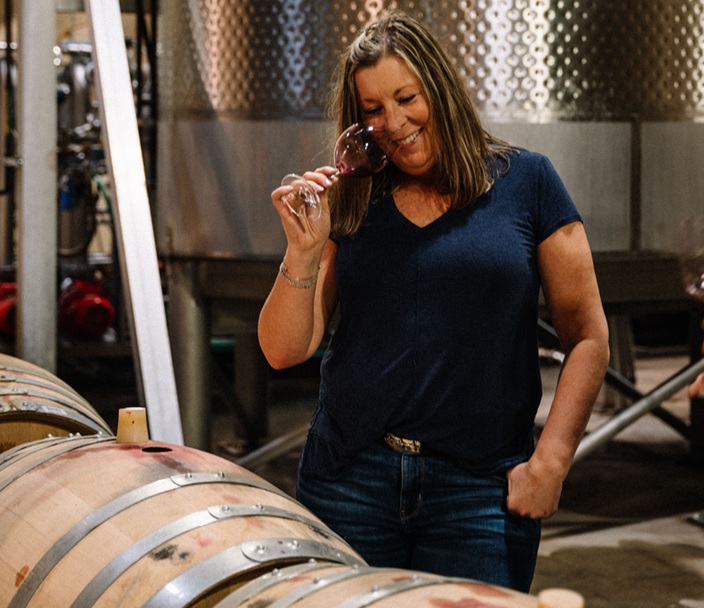
- UK-based wine consultant David Cowderoy emphasises the importance of having a diverse range of wines to work with, likening limited varietal options to painting with only a few colours. He also highlights the significance of the “15% rule”, where up to 15% of a different vintage or variety can be incorporated without compromising the label, but potentially enhancing the wine.
- Patience is a recurring theme in advice about blending. Winemakers caution against rushing, as wines need time to evolve.
- Many emphasise the importance of maintaining detailed records during blending trials. Accurate notes help track variations and outcomes, facilitating informed decisions in future blending sessions.
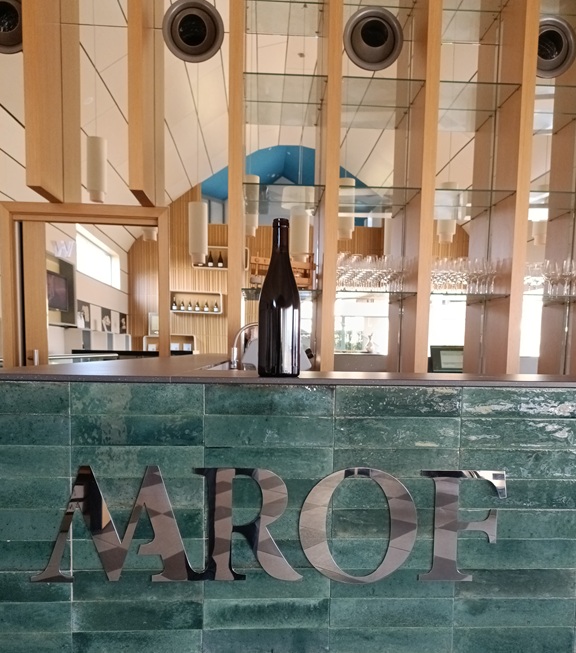
Confident I know the theory, I park outside the modern winery, which is designed to resemble an upturned ship. As I walk through the entrance, I’m imagining the process will take ages.
I wait for Uroš in the tasting room, with views of the main vineyard and more fish sculptures. Uroš steps down from his tractor. He likes to spend as much time as possible in the vineyard.
It’s a little daunting turning up at a winery with a view to making a superior blend to what’s already on offer. I also want to get it right to showcase the potential of this region, which Uroš refers to as “terra incognita” – an unknown or unexplored territory. I’ve given myself the whole day to craft the blend and ensure it is greater than the sum of its parts, but I’m wondering if that will be long enough.
Blending in practice
In practice, the blending turns out very different to how I imagine and very different to everything I had read about the art of blending wines.I knew Blaufränkisch had to be the dominant variety because it is a Slovenian grape. Yes, German scientists from the Julius Kühn Institute, Federal Research Centre for Cultivating Plants, discovered that it probably originates from Lower Styria (today’s Slovenia) and that Portugieser, which has the same mother (Blaue Zimmettraube), is also Slovenian.
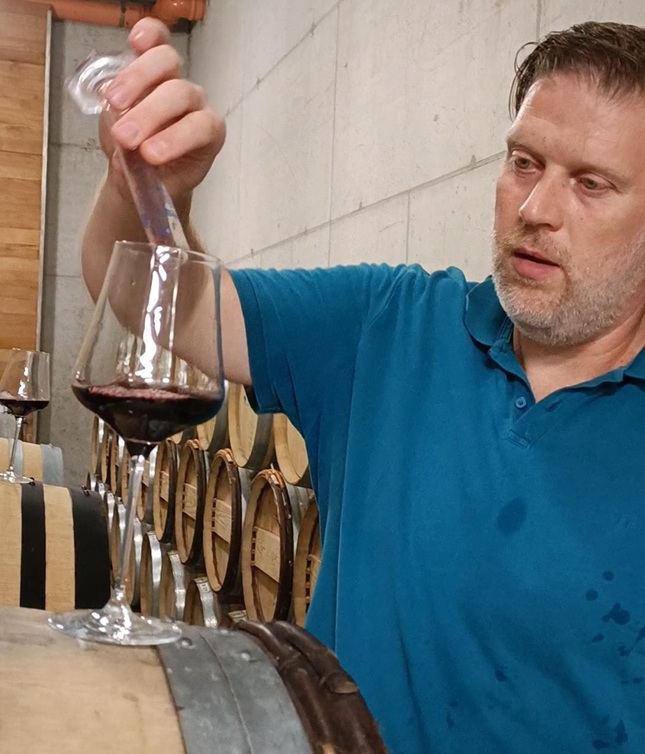
Uroš (above) points me in the direction of his 2020 reds, which he feels are nearly ready. I tell him my gut instinct is 80% Blaufränkisch for the base wine. We taste the wines from a large tank and a large barrel. I prefer the wine from the large barrel. It is fruitier, fresher, more complex and smoother than many of the Blaufränkisch wines I’ve tasted elsewhere in Slovenia, Austria and Hungary (where the variety is called Kékfrankos).
I also taste some superb Merlots from different French oak barrels and some experimental Cabernet Sauvignon from barriques.
We make up two glasses. One has 80% Blaufränkisch and 20% Merlot. This is a powerful wine and I like it a lot. The Merlot has swamped the Blaufränkisch, but it tastes wonderful. The rest of the Merlot is destined for a special release called SP, in honour of the founder of the winery, businessman Stanko Polanič, who died in 2023.
We also make up a glass with 80% Blaufränkisch, 10% Merlot and 10% Cabernet Sauvignon. This isn’t such an obvious wine; it is more subtle and complex and interesting. And this is the blend we opt for. We have created the recipe in less than 30 minutes.
I tell Uroš that I’d always imagined that winemakers pontificate for hours over the final blend, tweaking it with 1% here, 0.5% there. But Uroš believes that if you have good wines, the percentages aren’t so important – whatever they are, you will end up with a good wine.
“If the components are good, it doesn’t really matter,” he vouches. “Yeah, some people spend hours tasting, retasting, adding a percentage. We could also do this, but I’m not in this kind of way. I think it’s not so necessary.
“I strongly believe that if you do like one percentage, one percentage cannot bring such a difference in the wine.”
He adds: “Maybe it’s easier to put (a blend) together here. We have only two choices for the base wine – Blaufränkisch or Zweigelt.”
He points out that many – “too many” – blends are put together to cover up a poor wine or compensate for some characteristics that are absent in the main grape.
Not with this wine. All the individual components are outstanding. And surprising. This is not a wine region known for its reds – and certainly not for Merlot and Cabernet Sauvignon. But this wine proves it should be taken more seriously as a source for exciting, classy reds.
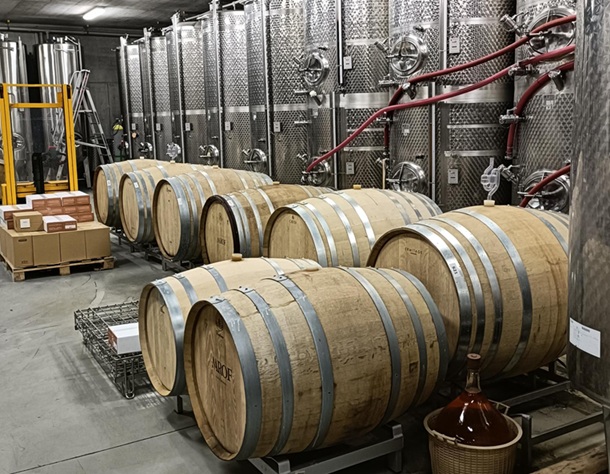
The Blaufränkisch was fermented in a stainless-steel tank and aged in a large oak barrel. The Merlot was fermented in a large conical barrel and aged in smaller barrels. The Cabernet Sauvignon was fermented in an open tub and aged in two barriques.
Total maceration time for all the wines was about 30 days, including about five days waiting for the native yeasts to take control. Uroš describes the extraction as “very gentle”. “I just pump and cover the cap two or three times a day for the first three or four days,” he explains of the Blaufränkisch.
The Merlot and Cabernet Sauvignon were hand-plunged once a day.
By the time the wines were racked from the fermentation vessels, they had also undergone spontaneous MLF.
It’s simple, low-intervention winemaking at its best.
Uroš sums up his winemaking philosophy for me: “Simplicity, I think, is the best. We do really hard work in the vineyards to produce very healthy, balanced grapes.
“We don’t use herbicides or insecticides. And in the cellar, it’s a very classical way of thinking. The focus is to get the wines to have the fingerprint of the vineyard.”

The tasting room at Marof, in the village of Mačkovci, looks over the vines that gave us this wine. It looks like an amphitheatre, with 5,000 Merlot plants in the cheap seats at the top. It’s mostly Blaufränkisch on the slopes down to the pond, with the 1,000 Cabernet Sauvignon vines on the far side. This vineyard also has some Zweigelt.
Marof cultivates approximately 100,000 vines in three single-vineyard sites in Mačkovci, Bodonci and Kramarovci. Blaufränkisch accounts for a third of the vines.
As we sip and nod approvingly at the new blend, Uroš gives me a history lesson. When Goričko was part of the Austro-Hungarian Empire (until 1918), the region was planted with Blaufränkisch (like neighbouring Burgenland in Austria). But very little was replanted after phylloxera struck the area and then, after the creation of the Kingdom of Serbs, Croats, and Slovenes, later renamed Yugoslavia, the northeast was ascribed white-wine production.
When food entrepreneur Stanko bought the old hunting lodge (now a beautifully renovated mansion that stands next to the new winery), he discovered the history and suitability of Blaufränkisch here. It is one of the sunniest and driest parts of Slovenia.
“The quality of the red here, it’s enormous. The fruit is really concentrated,” Uroš says. “You have always really ripe material. But it’s not overripe, it’s not jammy.”
'I think it’s fabulous'Reds now make up about 55% of the output at Marof. It’s mostly varietals plus a blend of Blaufränkisch and Zweigelt with a little Merlot and Cabernet Sauvignon.
“But just a little,” he stresses.
He takes another sip of my blend. “I think it’s fabulous,” he opines. “I think what you’ve done is great. The wine tastes really good.”
A job well done and I have the whole afternoon and evening free.
As I drive back to my own small vineyard near Jeruzalem, one of the key wine-producing villages in northeast Slovenia, I reflect on some of my other blending experiences. None has been protracted or stressful.
No-fuss blending
The blend for my classic-method sparkling wine – a world-first combination of Viktória Gyöngye (Pearl of Victoria) and Grüner Veltliner – took two attempts and about 40 minutes. It’s 50% Viktória Gyöngye, a Hungarian crossing of Seyve-Villard 12375 and table grape Pearl of Csaba, and 50% Grüner Veltliner – with half the Grüner fermented and aged in oak on lees for six months.At the Nádas Borműhely winery in Etyek, Hungary, when I suggested tweaking the blend a little longer, winemaker Szilárd Nádas dismissed the idea. He told me: “If the base wines are good, the sparkling wine will be good.” In other words, if the components are good, the percentages don’t really matter.
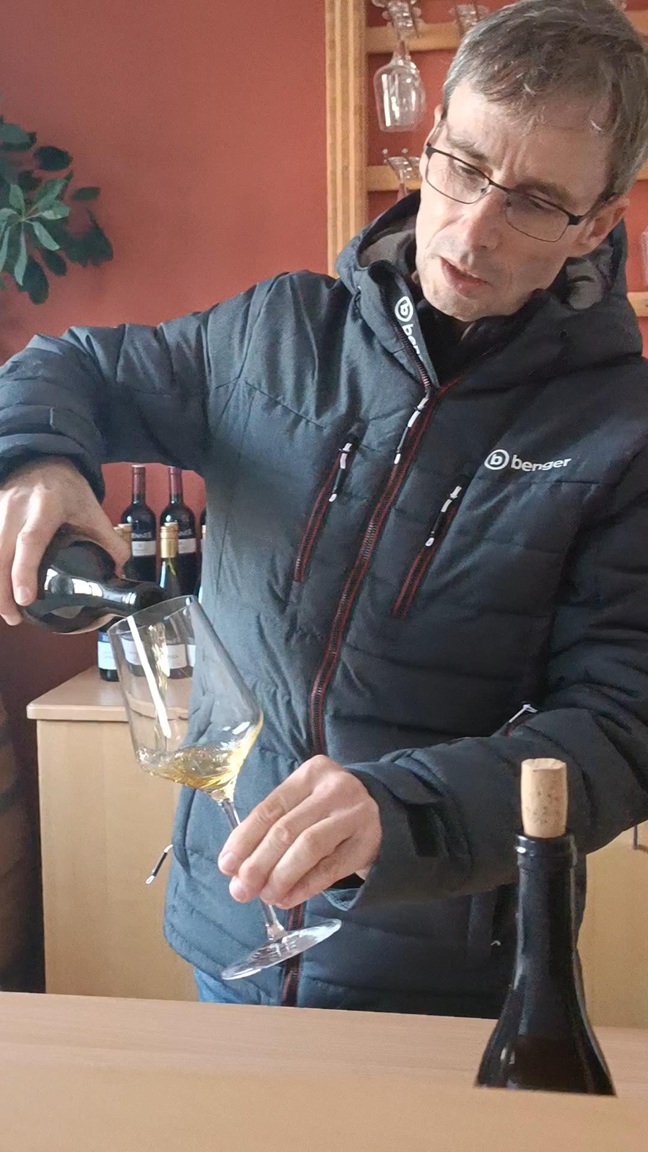
Sometimes it’s more about what you leave out. That was the lesson I learned blending my amber piwi wine in Austria.
At BioWeingut Karl Renner in Steiermark, we had experimented with two of the most exciting new-age fungal-resistant grape varieties: Muscaris, a crossing of Solaris and Muskateller, and Souvignier Gris, a pink-skinned crossing of Seyval Blanc and Zähringer (a crossing of Riesling and Traminer). As these are relatively new varieties, we made the Muscaris in amphora and steel, and the Souvignier Gris in oak, amphora and steel to see what worked best and to give us plenty of blending options. But the Muscaris in amphora leapt out of the glass in terms of aromas, flavours, complexity and balance – obviously it was going to be the chief component of our blend. Remembering the 85% rule, that’s what we opted for.
To keep things simple while adding some extra complexity and smoothness to the blend, we mixed in 15% Souvignier Gris from the other amphora bought specially for this project.
The blend is much more than I hoped for when I headed to Austria in 2022 to help elevate the image of piwi grape varieties. Indeed, when I poured the wine for top Italian sommelier Matteo Bernardi, he declared it to be “an orange wine like no other; a piwi wine like no other”.
Co-fermentations
Three of the wines in my unique collection, which promotes rare grape varieties and experimental winemaking, are co-fermentations. As the owner of an old mixed vineyard in Slovenia, I’m a big fan of field blends and co-ferments. I feel they often turn out more harmonious, exciting and complex than conventional blends.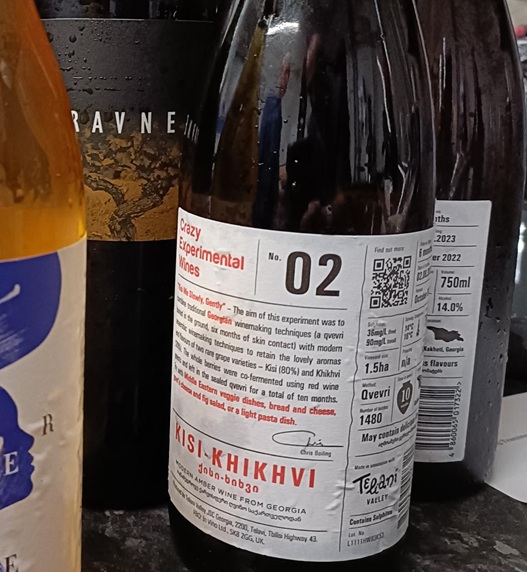
The first wine in the series is a Kisi and Khikhvi co-fermentation made in a qvevri in Georgia, at Teliani Valley’s Kindzmarauli Marani. The idea behind this experiment was to combine traditional Georgian winemaking techniques (a qvevri buried in the ground, six months of skin contact) with modern anaerobic winemaking techniques to retain the lovely aromas and flavours of two rare grape varieties that are indigenous to the Kakheti region – Kisi and Khikhvi. So, the qvevri was chilled to -1°C to receive the grapes; after a couple of days of manual punchdowns, we used netting and French oak staves fanned out like the spokes of a bicycle wheel to keep the cap submerged for the rest of the fermentation; after which the qvevri was sealed with glass and silicone; and the headspace was filled with nitrogen to prevent oxidation.
The second wine in the Crazy Experimental Wines portfolio is from Slovenia’s northeast, like the Blaufränkisch. But this is an orange wine: a pimped-up Laški rizling – a co-fermentation with whole Traminer berries. It tastes like an orange Gewürztraminer. The 25% Traminer berries spent 28 days in contact with the free-run from the Laški. It matured on lees in used oak at Vino Gross for a couple of years; the only thing added was a little SO2 prior to bottling.
The best of both worlds
I have made a premium red wine in Albania that features both a co-fermentation and blending. The local variety Debine e Zezë was co-fermented with small amounts of Merlot, Syrah and Pinot Noir – the Syrah helping to elevate the spiciness of the Black Debine. This co-fermentation was then blended with 40% of regional variety Mavrud, as that’s the signature grape of my collaborator, Max Mavrud, which owns some stunning vineyards in the south of Albania, near the border with Greece.The final wine, due to be released next year, will be a blend from French and Hungarian oak barrels.
It’s a wine that appears to push the art of blending to extreme levels but, in practice, it was very simple.
As I pull up at my little winehouse, Uroš’s words are still echoing in my brain: “If the components are good, it doesn’t really matter.”

 English
English French
French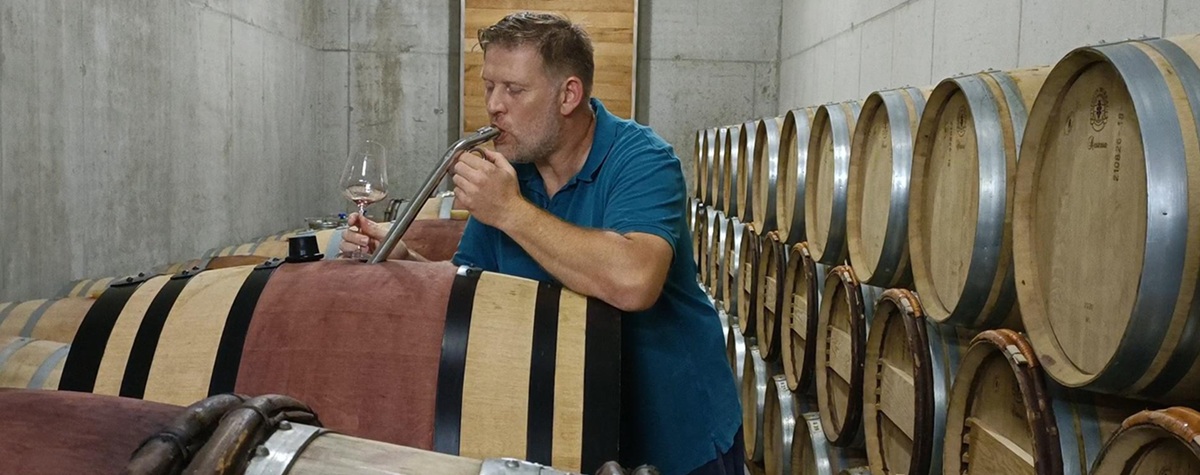

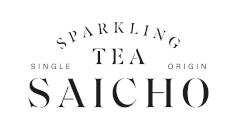

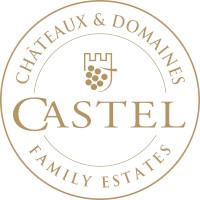


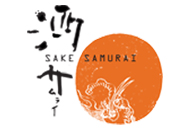
.png)


